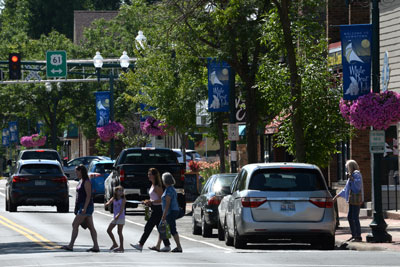Regional Pedestrian Safety Action Plan
 All people throughout the region should have access to safe and comfortable places to walk or roll to reach the places in their daily lives. These places should support walking and rolling and protect people who are using those facilities from harm from vehicles throughout their trip.
All people throughout the region should have access to safe and comfortable places to walk or roll to reach the places in their daily lives. These places should support walking and rolling and protect people who are using those facilities from harm from vehicles throughout their trip.
Prioritizing pedestrians in road design is one of the most effective ways to ensure safety for those who walk and roll.
Current state
More people who are walking are being killed or seriously injured by drivers across our transportation system. These deaths and serious injuries are on the rise and are an increasing percentage of all crashes. Meanwhile, other types of traffic-related deaths and injuries are decreasing.
Walking represents only 6% of all trips in the seven-county metro area; however, between 2014 and 2018, pedestrians experienced 34% of all traffic fatalities. These data also show that while the metro area has 55% of state’s pedestrian fatalities, it has only 25% of the state’s overall traffic fatalities.
Study goal
The Met Council worked with Toole Design and Kaskaskia Engineering Group on an analysis of pedestrian crash data, and other relevant data, to develop recommendations to guide effective infrastructure investments and improvements.
Overall, the plan’s goal is to reduce and ultimately eliminate pedestrian deaths and serious injuries from traffic crashes in the metropolitan planning organization planning area. This includes the seven-county metro area plus the urbanized portions of Wright and Sherburne counties.
The study uses a safe systems approach. Safe systems put people at the center of roadway design by fully integrating the needs of all users of the transportation system. This approach recognizes that:
- People make mistakes
- Human bodies are vulnerable
- Deaths or serious injuries are not acceptable
- Redundant safety measures create layers of safety
- Responsibility is shared
- Infrastructure is key
Analysis and key findings
Most of the region’s pedestrian crashes where someone is killed or seriously injured happen in Hennepin or Ramsey counties. While the numbers are lower for suburban counties, the severity of pedestrian crashes tends to be higher in suburban counties.
Most pedestrian crashes, deaths, and serious injuries are happening on roads with speed limits of 20 to 30 mph. As speeds increase, the severity of these crashes increases.
About 80% of severe pedestrian intersection crashes and 50% of mid-block crashes happen near transit stops. There is no evidence that transit causes crashes. Transit stops, however, are a proxy for high pedestrian exposure.
Severe pedestrian crashes disproportionately happen on minor arterial roadways. These are high volume, urban roads that deliver traffic from collector roads to freeways and to/from urban centers.
- 64% of severe pedestrian crashes happen on minor arterials, which represent only 14% of the roadway network.
- 11% of severe pedestrian crashes happen on local/residential roads (74% of the network)
Black and Native communities are disproportionately harmed by pedestrian crashes. These findings may be linked to exposure, but they closely mirror historic patterns of disinvestment and racially biased lending practices.
- Census tracts with higher shares of Black or Native residents have more pedestrian crashes. Tracts with higher shares of white residents have fewer pedestrian crashes.
- 14% of pedestrian deaths were Black people compared to 9.6% of the population.
- 2.3% of pedestrian deaths were Native people compared to 0.48% of the population.